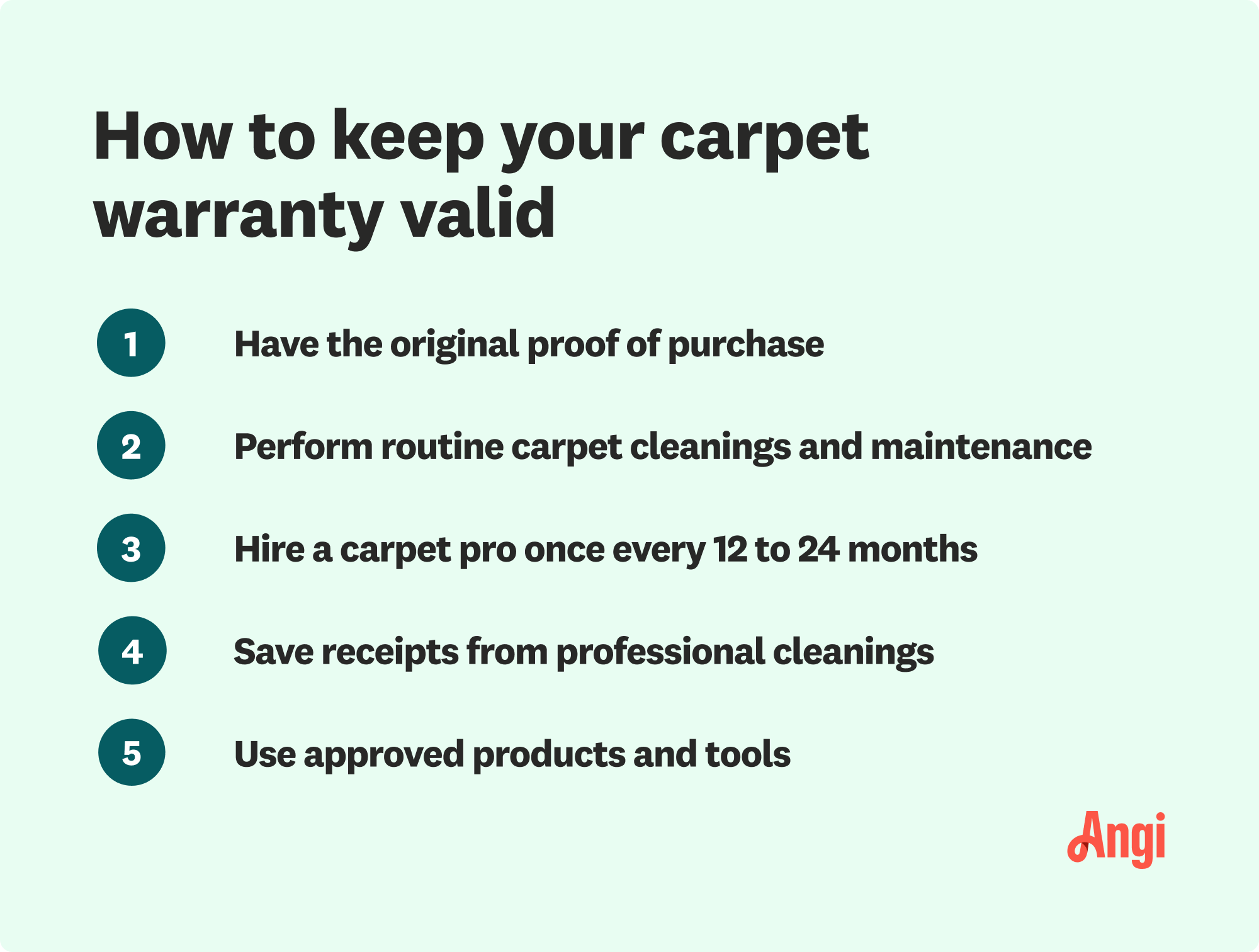How Does Carpet Cleaning Affect Warranties?
Breaking down the fine print on a carpet warranty is a must before you soak, scrub, or scour that shag


Carpets can hold four times their weight in dust and bacteria.
Carpet costs $1–$20 per square foot to install.
Some carpet warranties are standard, while others come at a cost.
You can clean your carpet yourself, but professional cleanings may be required.
Read the fine print on a warranty before a deep cleaning.
When’s the last time you pumped some iron? You may want to head to the gym when you learn your carpet’s been doing plenty of heavy lifting. Your floor’s twisted tufts can hold as much as four times their weight in dirt, pet hair, dead skin cells, insect feces, bacteria, mold, and more. So regular cleaning makes total sense.
"One way to combat fiber loss is frequent vacuuming," says Asya Biddle, Angi Expert Review Board member and manager of The Dustbusters, a family-owned and operated janitorial company in Williamsport, PA. "Vacuuming helps to remove dirt and debris that break down and damage the carpet fibers, effectively maximizing the overall life of your carpet."
But before you tackle filthy flooring, make sure you understand how carpet cleaning affects any warranties you may have. Need a little guidance? We’ve got you covered.
Different Types of Carpet Warranties
Just like cars, laptops, and even lava lamps, a new carpet purchase is likely to offer a warranty. There are multiple types of carpet warranties, all with their own terms and fine print. Some of the most common types are below.
Wear Warranty
Also known as a quality assurance warranty, a wear warranty covers fiber deterioration. You’ll want to check the manufacturer’s definition of “wear,” but this standard warranty typically designates 10% fiber loss as a threshold.
Stain Warranty
Stain-resistant doesn’t mean stainproof. So when you see an unsightly spot, this type of warranty might come in handy. However, you’ll find plenty of exclusions, and certain spills might not even be covered. Knowing the proper actions to take immediately following a spill (as defined by the manufacturer) will help keep this warranty intact.
Carpet Installation Warranty
Improperly installed carpet is prone to damage. Without this warranty from your carpet installer, the manufacturer may void any warranties. While some contracts are standard, others are available at an additional cost. Choosing your carpet color and style is important, but don't skip out on choosing additional warranties that may protect your investment.
How to Keep Your Carpet Warranty Valid

Now that you have your warranty ducks all in a row, how do you make sure they stay valid? While the answer to this will depend on the verbiage of your warranty, there are a few basic steps you can take.
Proof of Receipt
To proceed with a warranty claim, you’ll need to have the original proof of purchase along with the warranty information handy.
"This is the hardest part of any carpet warranty," Biddle says. "There must be a warranty receipt graveyard somewhere!"
Regular Cleaning
You shouldn’t avoid cleaning your carpets to preserve the warranty. The opposite is actually true. Regular vacuuming is just one of the essential elements of the carpet cleaning process. This helps keep your carpet clean and prevent heavy buildup, while professional cleaning removes allergens and disinfects.
Approved Products
Professional cleaning is recommended (and often required) by many carpet warranties. While you can do some DIY stain removal with your own carpet cleaning equipment, you want to ensure you only use products approved by your manufacturer.
Generally speaking, a few tools and products to never use on carpet include:
Dry foam
Bonnet
Dry powders
Rotary brush
Professional Carpet Cleaning
Professional carpet cleaning not only freshens and restores your carpet's appearance, but it's also a common term in a warranty contract. If your carpet needs some TLC, reach out to a professional carpet cleaner near you.
Unsightly stains aren't the only reason to clean your carpet. Remember that they can harbor dangerous bacteria, allergens, and mold. Carpet warranties often specify that a pro must do the carpet cleaning, usually using hot water extraction. The exact frequency will vary by warranty, but once every 12 to 24 months is standard. Save each cleaning receipt to prove you maintained a regular professional cleaning schedule.
Carpet Care and Maintenance
Keeping your carpet warranty intact comes down to proper care and maintenance. Here are a couple of tips for carpet care.
Clean Up Spills Right Away
Different liquids and stains have different cleaning approaches. For example, vacuum up mud after it dries, while you need to blot, dilute, and treat a wine spill immediately with baking soda and water. Always research how to clean a spill or stain properly before diving in.
Vacuum Like a Pro
Vacuum at least twice a week to prevent debris from sinking deep into the fibers. Vacuum slowly and start by going in one direction. Then, rotate the vacuum 90 degrees and go over the same areas again. Don’t forget to periodically move furniture and use the attachment to get corners and hard-to-reach areas.
Determining If Carpet Warranties Are Worth It

According to HomeAdvisor, the average cost to install or replace carpet costs between $790 and $2,800. Determining a ballpark figure comes down to the square footage you need to cover and the carpet grade you choose. Builder-grade carpet (or economical carpet) can be as low as $1 per square foot, while a high-grade rug can be as much as $20 per square foot.
When deciding if a warranty for your carpet is worth it, consider how much it would cost to replace. Compare this to the cost of the warranty. You may also want to consider the likelihood of your carpet being damaged. Having pets, children, or the carpet placed in a high-traffic area will make damage more likely.
Warranties can provide peace of mind, but they aren’t a requirement if you don’t feel the price is worth it.















